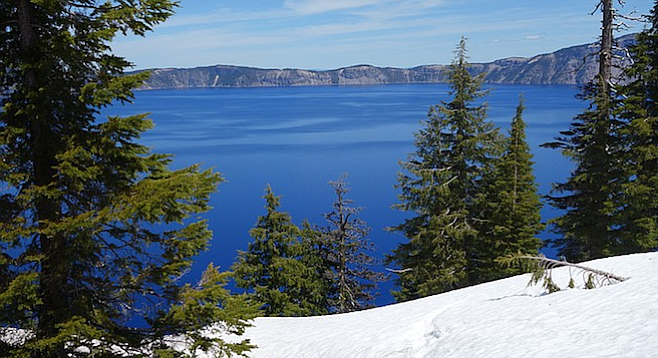- Oregon’s only national park, site of the deep blue Crater Lake.
Remembering Crater Lake
Childhood memories revisited in America’s deepest lake and national park.
By Karin Leperi, March 20, 2016 from the San Diego Reader
The mountain switchbacks seemed endless as Dad drove the Ford station wagon with our family of six from Portland to Crater Lake National Park.
We stopped just short of the park entrance for a leisurely picnic of cold cuts and sandwich makings from our ice chest, an economizing large-family ritual. Before tailgating was ever a thing, our station wagon had a pullout with a picnic table.
With the midday meal finished, we headed for the entrance. I thought we’d found heaven on earth.
“Why is the water such a deep cobalt blue?” I prodded my parents, proudly showcasing my budding-artist knowledge of oil paint colors.
My engineer father responded in his pedantic way. “The navy blue coloration you see is because other colors in the light spectrum are absorbed while the shorter blue wavelengths are what is visual to the naked eye.”
I had never seen waters so blue. Along with the pervasive smell of fresh pine in the air, I was intoxicated with the magic of the place. It was the middle of July, but my older sister Margo remarked how cold it was as we stared at the lake from the outlook. Even as she spoke a northerly breeze added a chill to the air. (I since learned that the average daily high in August is only 69 degrees F).
Oregon’s only national park
Surprisingly, Crater Lake is Oregon’s only national park. Remotely located in southern Oregon along the Cascade crest, the park spotlights the deepest lake in North America. And if that isn’t enough to impress, Crater Lake is also considered the clearest and the cleanest large body of water in the world.
About 7,700 years ago, Crater Lake was created when a powerful volcanic eruption caused the 12,000-foot volcano to collapse, forming a caldera eventually filled with rain and the spring melt of winter snows. (No rivers or streams feed the lake). Subsequent eruptions occurred on the caldera floor, with Wizard Island – technically called a cinder cone – being one of these. During the summer you can take a boat tour of the lake with a brief stop at Wizard Island, where you can check out the 800-year-old trees that somehow have managed to survive.
Remembering the deep blue
Remembering that magical time, I made plans to go back with my friend Margo, who lived only a couple hour’s drive away. I guess I wanted to see if Crater Lake was still so dark blue after all these years.
I arrived at her place in late May, surprising her with my plans for a park visit. I would be driving my rental car and assured her that snow would not be an issue. My idea was to arrive before noon to get our requisite photo ops along the way. With several hours to visit, I figured we would head back around 2 p.m. and easily be back before dark.
Armed with Google info and Map Quest, we set out on the most direct route to the North Rim entrance. Unfortunately, my research failed to cue me in on a most pertinent fact: the North Rim entrance is seasonally closed, from the beginning of November through June. (Detour signs were my first clue.) Hard to believe that the park is covered in snow almost eight months a year, with snow sticking around into July.
That effectively translated into driving an additional 50 miles to the west entrance, adding another 90 minutes to our ETA. (The park’s southern and western entrance are accessible year-round).
After a long 50 miles of mountain driving, we eventually arrived at the west entrance, where I presented my newly acquired park pass, Next, we stopped at the visitor center, where Margo and I perused the exhibits and watched a movie about the Mount Mazama, once one of the highest peaks in the Cascades at 12,000 feet.
At a depth of 1,943 feet, Crater Lake’s water level is maintained by precipitation and seepage only, one of the reasons the water is so pure, clear, and deep blue. And much like Dad explained to us so many years earlier, the deep blue color results from blue and green reflecting light waves bouncing off colorless water without any suspended sediment.
Because we were running later than expected, our next stop was lunch at The Rim Village Café. It offers a selection of hot soups, sandwiches, salads and snacks – reasonably priced considering the distance they have to haul food supplies. We enjoyed the remarkably good turkey sandwiches as we parked ourselves on the second deck, taking in a window view overlooking the lake.
We only had an hour to get our lake photos, so we jumped into the car heading for the nearest pullout.
And then, there it was. With white snow framing the banks and a royal blue sky above, I savored the moment, entranced by the lake: a repeat of so many years prior. And yes, Crater Lake is still a deep, cobalt blue – the color of childhood memories.
***previous*** — ***next***


